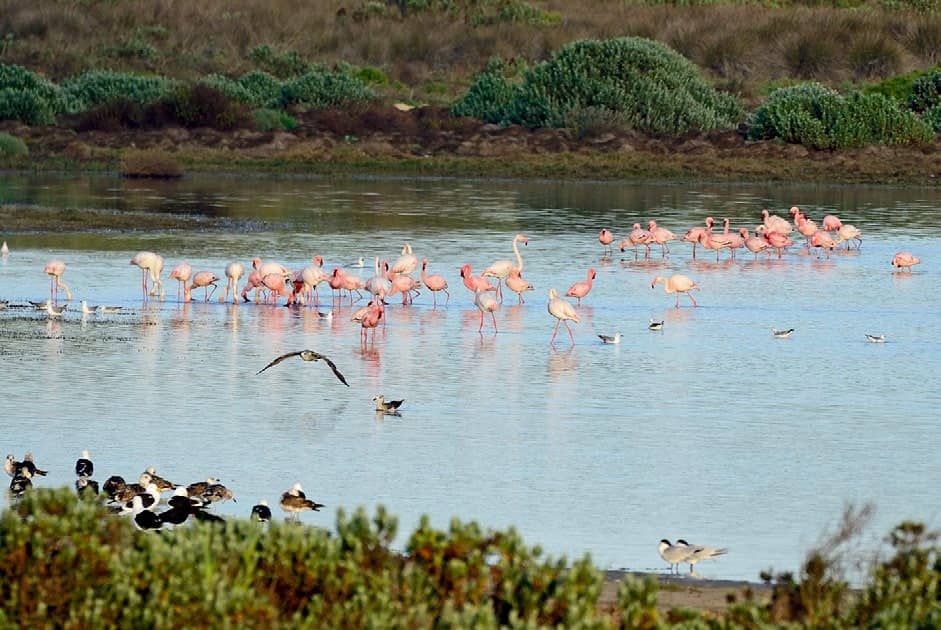Try GOLD - Free
And Breathe... Rocherpan Nature Reserve
African Birdlife
|January - February 2021
After the pandemic’s catastrophic impact on travel and finances, everyone has been constrained to look closer to home for their much-needed breakaways. Fortunately for South Africa’s birders, there are several local spots that are easily accessible, affordable and well worth a visit. One such oasis is Rocherpan Nature Reserve on the Cape’s West Coast. Managed by CapeNature, the reserve is 25 kilometres north of Velddrif and just two hours’ drive from Cape Town.

Rocherpan is a relatively small reserve (1080 hectares), a slice of land sandwiched between the Atlantic Ocean and a fairly busy road, but the combination of ecosystems – a seasonal pan/wetlands, marine/beach environment and strandveld vegetation – offers a variety of bird habitats. More than 183 bird species can be found here, including 70 waterbirds. A full bird list is available on the CapeNature website or at the reserve’s reception. In the three days we spent in the sanctuary, even as birding novices we managed to see and identify approximately 60 species relatively easily.
The pan is obviously the main feature of the reserve and there are three bird hides where you can while away the hours watching water birds and waders. Greater and Lesser flamingoes, Kelp, Grey-headed and Hartlaub’s gulls, Avocets, Black-winged Stilts, cormorants, ducks and geese in great numbers bathed, fed, slept and squabbled in front of the hide. Caspian and Swift terns settled among the gulls, while Kittlitz’s, Three-banded and White-fronted plovers and sandpipers worked their way along the pan’s shoreline. African Oystercatchers were ever-present, sometimes in pairs, but often in small groups. Rocherpan is one of the Cape Shoveler’s most important breeding sites and we were glad to see a pair drifting along on the water.
Just alongside the bird hide, Cape and Southern Masked weavers and Southern Red Bishops kept up a continuous chorus in the reeds. An older, unused bird hide further down the pan seems to have been appropriated by a Rock Kestrel as a base for its hunting missions.

This story is from the January - February 2021 edition of African Birdlife.
Subscribe to Magzter GOLD to access thousands of curated premium stories, and 10,000+ magazines and newspapers.
Already a subscriber? Sign In
MORE STORIES FROM African Birdlife

African Birdlife
Southern SIGHTINGS
MID-JULY TO MID-SEPTEMBER 2025
2 mins
November/December 2025

African Birdlife
BLUE CRANE
A symbol of pride and vulnerability
6 mins
November/December 2025

African Birdlife
CHAOS AT THE KOM
Between 1 and 3 December 2024 there was a remarkable sardine run off Kommetjie on the Cape Peninsula.
1 min
November/December 2025

African Birdlife
Ramsar Convention on Wetlands
Whatever form they take, from peatlands to estuaries, wetlands are critical for the survival of waterbirds, such as the White-winged Flufftail, Maccoa Duck and Grey Crowned Crane. They are highly productive ecosystems that are characterised by diverse and abundant food sources and they provide essential feeding, breeding, migratory and resting habitat for numerous species. iSimangaliso Wetland Park, for example, supports more than 500 bird species.
1 mins
November/December 2025

African Birdlife
FRAMING wild feathers
WINNERS OF THE BIRDLIFE SOUTH AFRICA PHOTOGRAPHY COMPETITION 2025
4 mins
November/December 2025

African Birdlife
PITTA PILGRIMAGE
Look there - on that branch, behind those green leaves!’ Crouching in thick forest, with sweat dripping, heart pounding and eyes straining, I frantically searched with my binoculars, trying to work out which branch, which green leaves - indeed, which darned tree? I was close to panicking as we had come so far, and yet I just couldn't see where our guide was pointing.
4 mins
November/December 2025

African Birdlife
Unlocking a DIGITAL WORLD of bird stories
For more than 75 years, the South African Bird Ringing Unit (SAFRING), now hosted by the FitzPatrick Institute of African Ornithology, has woven together the complex life stories of southern Africa's birds.
1 mins
November/December 2025
African Birdlife
MIRRORLESS MARVEL
Testing Canon's R1 in the field
3 mins
November/December 2025

African Birdlife
Is NECHISAR NIGHTJAR a hybrid?
Vernon Head's award-winning book The Search for the Rarest Bird in the World brought widespread attention to the curious case of the Nechisar Nightjar. In 1992, a dead nightjar was found on a dirt road in Nechisar National Park, southern Ethiopia. A wing was collected and the bird was later described as a new species based on its distinctive large white wing patch. Its scientific name, Caprimulgus solala, attests to the fact that it is known only from a single wing.
2 mins
November/December 2025

African Birdlife
a TALL Tail
In the high grass of eastern South Africa, midsummer is when the Long-tailed Widowbird transforms the veld into a stage.
1 min
November/December 2025
Translate
Change font size

